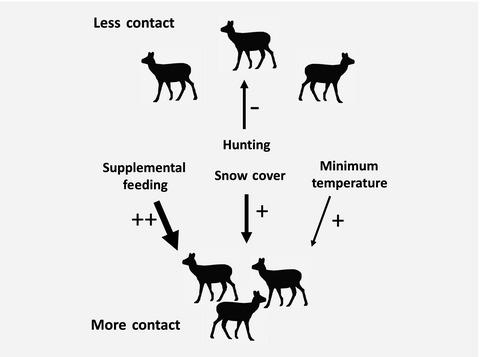当前位置:
X-MOL 学术
›
J. Appl. Ecol.
›
论文详情
Our official English website, www.x-mol.net, welcomes your
feedback! (Note: you will need to create a separate account there.)
Human activities and weather drive contact rates of wintering elk
Journal of Applied Ecology ( IF 5.0 ) Pub Date : 2021-01-25 , DOI: 10.1111/1365-2664.13818 William M. Janousek 1 , Tabitha A. Graves 1 , Ethan E. Berman 1 , Geneva W. Chong 2 , Eric K. Cole 3 , Sarah R. Dewey 4 , Aaron N. Johnston 2 , Paul C. Cross 2
中文翻译:

人类活动和天气驱动越冬麋鹿的接触率
更新日期:2021-03-02
Journal of Applied Ecology ( IF 5.0 ) Pub Date : 2021-01-25 , DOI: 10.1111/1365-2664.13818 William M. Janousek 1 , Tabitha A. Graves 1 , Ethan E. Berman 1 , Geneva W. Chong 2 , Eric K. Cole 3 , Sarah R. Dewey 4 , Aaron N. Johnston 2 , Paul C. Cross 2
Affiliation

|
- Wildlife aggregation patterns can influence disease transmission. However, limited research evaluates the influence of anthropogenic and natural factors on aggregation. Many managers would like to reduce wildlife contact rates, driven by aggregation, to limit disease transmission. We develop a novel analytical framework to quantify how management activities such as supplemental feeding and hunting versus weather drive contact rates while accounting for correlated contacts. We apply the framework to the National Elk Refuge (NER), Wyoming, USA, where the probable arrival of chronic wasting disease (CWD) has magnified concerns.
- We used a daily proximity index to measure contact rates among 68 global positioning system collared elk from 2016 to 2019. We modelled contact rates as a function of abiotic weather‐related effects, anthropogenic effects and aggregation from the prior day. The winter of 2017–2018 had greater natural forage availability and little snow, which led to a rare non‐feeding year on the NER and provided a unique opportunity to evaluate the effect of feeding on contact rates relative to other conditions.
- Supplemental feeding was the strongest predictor of aggregation, and contact rates were 2.6 times larger while feeding occurred compared to the baseline rate (0.34 and 0.13, respectively). Snow‐covered area was the second strongest predictor of contact rates highlighting the importance of abiotic factors to elk aggregation, but this effect had half the strength of feeding. These results are the first to show, even in animals that congregate naturally, how greatly supplemental feeding amplifies aggregation. Contact rates were also 23% lower during times when elk hunting was active (0.10) compared to the baseline.
- Synthesis and applications. Supplemental feeding increased contacts between elk well above the natural effects of weather, even after accounting for correlated movement expected in wintering ungulates. Similarly, differences in hunting season timing with adjacent areas led to an increase in contacts, suggesting an additional management option for reducing aggregation. The analytical framework presented supports the evaluation of temporally varying management actions that influence aggregation broadly and can be easily implemented whether the interest in changing aggregation is related to reduction of disease transmission, human–wildlife conflict or inter‐species competition.
中文翻译:

人类活动和天气驱动越冬麋鹿的接触率
- 野生动物的聚集方式会影响疾病的传播。但是,有限的研究评估了人为因素和自然因素对聚集的影响。许多管理者希望通过聚集来降低野生动植物的接触率,以限制疾病的传播。我们开发了一种新颖的分析框架,以量化管理活动(例如补充喂养和狩猎与天气的关系)如何在计算相关联系的同时提高联系率。我们将该框架应用于美国怀俄明州的国家麋鹿庇护所(NER),那里的慢性消耗性疾病(CWD)可能到来已经引起了人们的关注。
- 我们使用每日接近指数来衡量2016年至2019年间68个全球定位系统的圈养麋鹿之间的接触率。我们将接触率建模为前一天与非生物天气相关影响,人为影响和聚集的函数。2017-2018年冬季,自然草料供应量更大,降雪少,这导致NER罕见的非饲草年,并提供了一个难得的机会来评估饲喂对接触率的影响(相对于其他条件)。
- 补充喂养是最强的聚集预测指标,而发生喂养时的接触率是基线率的2.6倍(分别为0.34和0.13)。冰雪覆盖的面积是接触率的第二大预测指标,突显了非生物因素对麋鹿聚集的重要性,但这种作用只有一半的进食强度。这些结果首次显示,即使在自然聚集的动物中,补充喂养在多大程度上放大了聚集。与基线相比,麋鹿狩猎活跃时期(0.10)的接触率也降低了23%。
- 综合与应用。即使考虑到冬季有蹄类动物的预期相关运动,补充饲喂也能使麋鹿之间的接触远超过天气的自然影响。同样,与邻近地区的狩猎季节时间安排的差异也导致了接触的增加,这为减少聚集提供了一种额外的管理选择。提出的分析框架支持对广泛影响汇聚的随时间变化的管理行动进行评估,无论改变汇聚的兴趣与减少疾病传播,人类与野生动物的冲突还是种间竞争有关,都可以轻松实施。











































 京公网安备 11010802027423号
京公网安备 11010802027423号